#Museum of Hungarian Agriculture
Text

Museum of Hungarian Agriculture, Budapest, HUNGARY
163 notes
·
View notes
Text
Vajdahunyad Castle

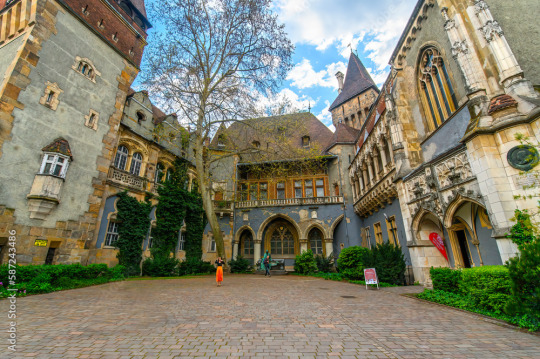
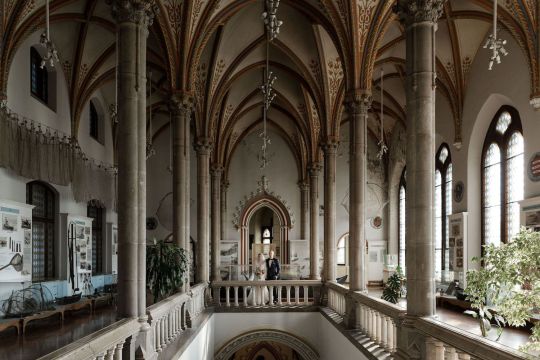

Vajdahunyad Castle is located in the City Park of Budapest, Hungary. Built in 1896 on Szechenyi Island as part of the Millennial Exhibition celebration, the castle is accessible by four bridges. The buildings were modeled after famous buildings erected in Hungary. It was meant to be temporary and was originally built of cardboard and wood, but the citizens enjoyed the complex, so it was reconstructed from 1904-08 with permanent materials. The complex consists of several buildings with various architectural designs from the Middle Ages to the 18th century meant to be displayed in one composite castle. The Romanesque-style buildings and structures from the 11th-13th century include Vajdahunyad Castle, the Chapel of Jak, an Auditory, the 37-meter-tall Tower of Torture, the Tompa Tower, the Lion Bridge, the Bastion Tower of Segevar, and more. Gothic architecture from the 14th-15th centuries is also seen in Vajdahunyad Castle, which is a replica of what many believe was Count Dracula’s home. The Baroque palace represents Renaissance and Baroque architecture from the 16th-18th centuries and includes a cupola over the main entrance. The museum has eight permanent exhibitions, and the property also serves as a venue for festivals and more. The structures boast stained glass windows, painted vaulted ceilings, wooden beams, marble staircases, and medieval turrets. Vajdahunyad Castle currently serves as the Museum of Hungarian Agriculture.
10 notes
·
View notes
Text

Museum of Hungarian Agriculture, Budapest Hungary
11 notes
·
View notes
Text

Vajdahunyad Castle is one of the romantic castles in Budapest, Hungary, located in the City Park by the boating lake / skating rink. The castle, despite all appearances, was built in 1896, and is in fact a fantasy pastiche showcasing the architectural evolution through centuries and styles in Hungary. The castle is the home of several festivals, concerts and the exhibitions of the Hungarian Agricultural Museum. Vajdahunyad Castle amalgamates some of the finest buildings in the historical Hungary into a single eclectic palace featuring styles from the Middle Ages to the 18th century: Romanesque, Gothic Renaissance, Baroque buildings, from the Romanesque church of the village Jak to the Baroque palace of Prince Paul Esterhazy I.
5 notes
·
View notes
Text
WONDERFUL CIRCUS WORLD LA MOSTRA A BUDAPEST

WONDERFUL CIRCUS WORLD LA MOSTRA A BUDAPEST
Nell’ambito delle manifestazioni collaterali al 15º Budapest Circus Festival, si sono tenute alcune conferenze dell'Eca (European Circus Association) ma soprattutto, nella giornata di venerdì, è stata inaugurata Wonderful Circus World, una grande mostra sulla storia del circo. La location della mostra è molto suggestiva essendo organizzata nel castello di Pest (non molto distante dal circo stabile) dove già attualmente risiede un museo dell’agricoltura. Ce la racconta Massimo Malagoli.

La mostra è organizzata in diverse sale dove è esposto molto molto materiale, come manifesti, costumi, sgabelli e testali di elefanti, finimenti per cavalli, scarpe e tantissimi altri oggetti.


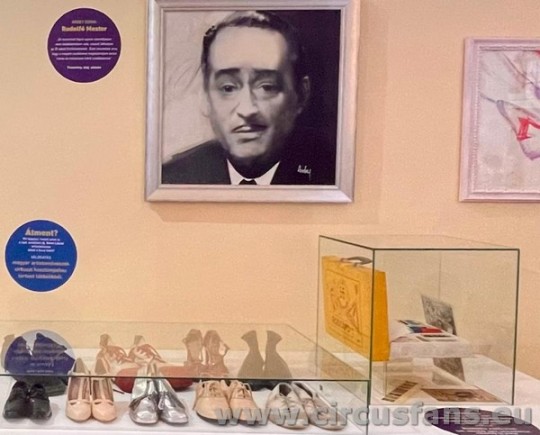
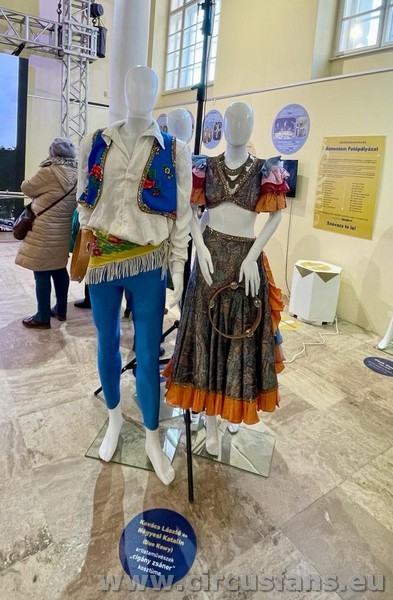
Una delle sale più grandi è dedicata al circo ungherese di un po' tutte le epoche, dal passato a quello più recente. In questa sala, si trovano costumi di famosi artisti che hanno fatto la storia del circo, sia ungherese sia internazionale. Viene proposto materiale che copre almeno gli ultimi 60 anni.


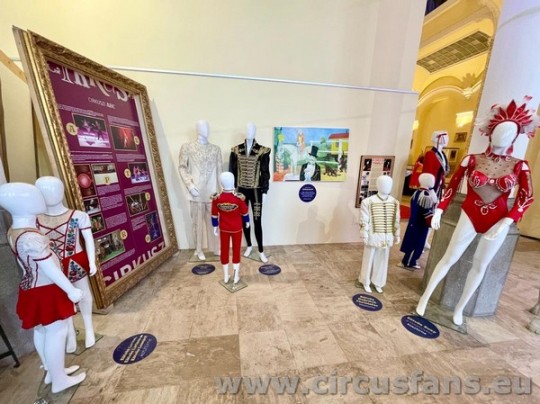
Fra i costumi più recenti, ve ne sono alcuni appartenenti alla famiglia Eotvos (ndr Susy Eotvos attualmente è responsabile delle relazioni internazionali del Festival, mentre al famiglia di Lorand Eotvos, con il suo numero di giocoleria, è attualmente nel programma del circo Busnelli) e alla famiglia Richter.
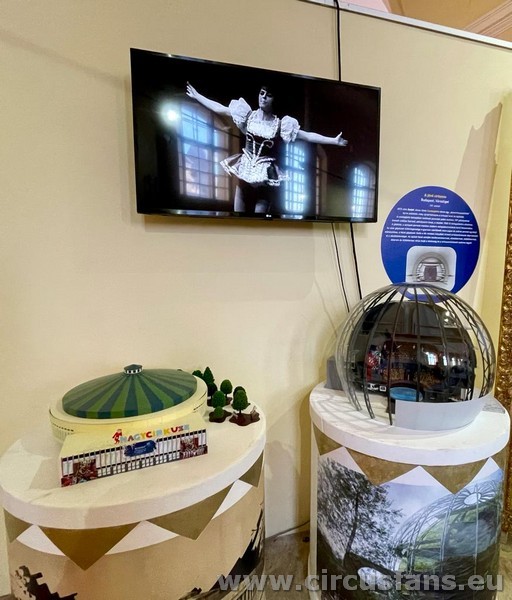
Un ponte tra passato e futuro sono poi i due plastici del circo stabile di Budapest, il plastico del circo attuale e di quello di prossima realizzazione.

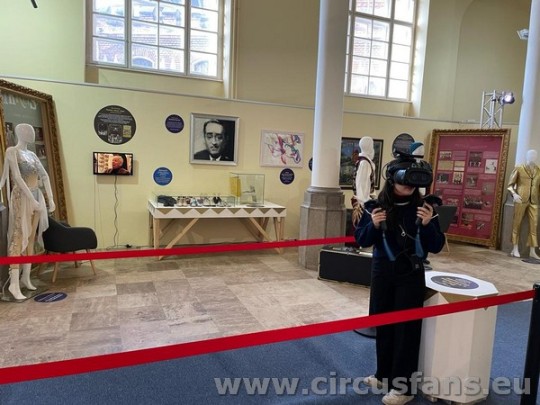
Ma c’è anche un grande schermo dove viene proiettata la celebre camminata sul Danubio di Lazlo Simet. Molto suggestiva è la possibilità, grazie alla realtà virtuale di provare a vivere un’esperienza analoga.

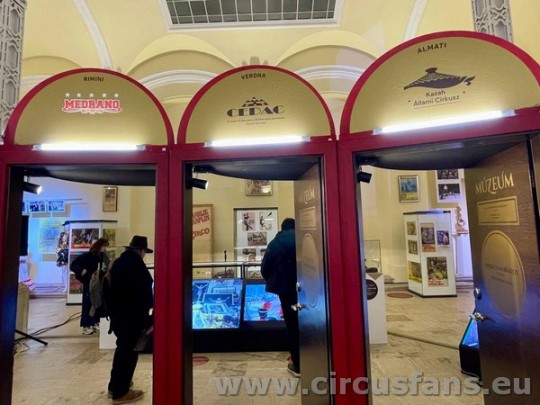
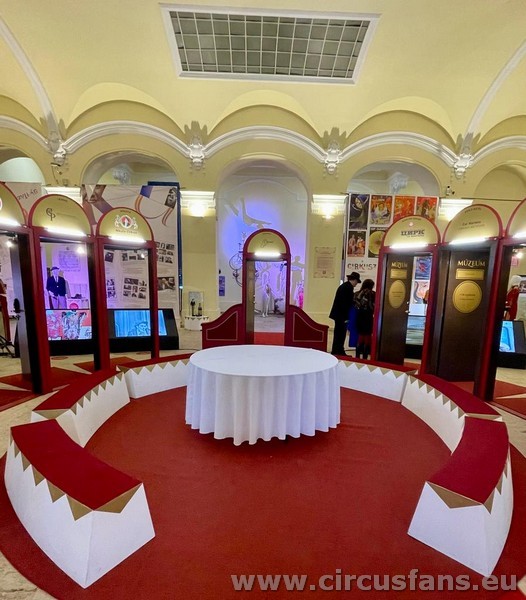

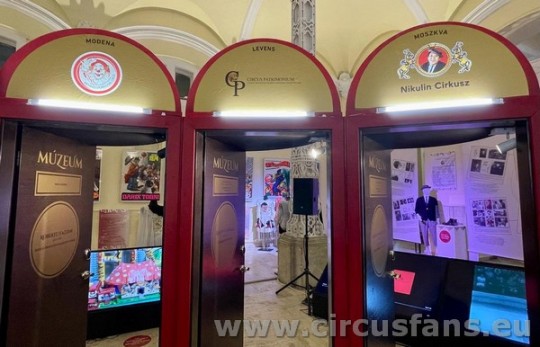
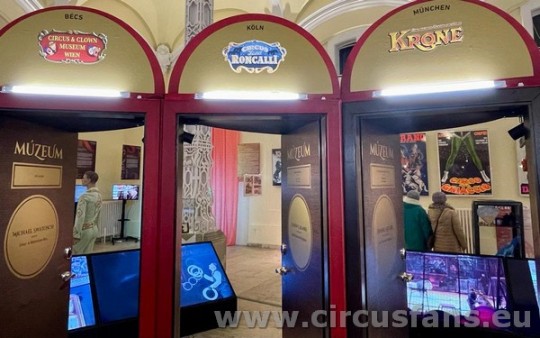
Un’altra grande sala è invece dedicata al circo europeo e alla sua storia, grazie anche al contributo di una dozzina di collezionisti molto rinomati che hanno prestato parte del proprio materiale. Fra questi il Cirque d’Hiver Bouglione, il circus Krone, il Circus & Clownmuseum di Vienna, il circus Roncalli ma una parte molto importante è rappresentata anche dal contributo italiano grazie al materiale del Cedac, del Circo Medrano e del Museo del Circo di Fiabilandia voluto e curato da Davio Casartelli e alla collezione di Roberto Fazzini.



Alcuni degli oggetti esposti fra i quali si può ammirare il costume le scarpe di Nikulin, un costume di Martin Lacey jr e uno di Christel Sembach-Krone.
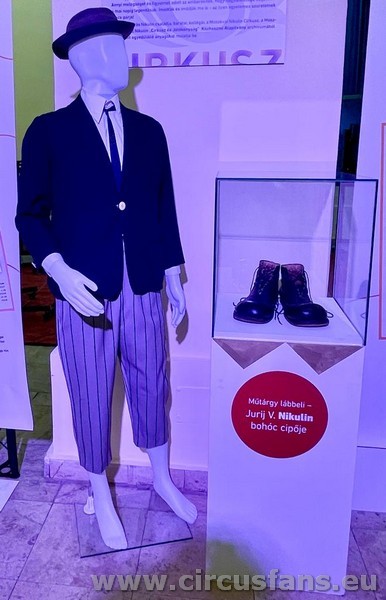

Dalla collezione di Roberto Fazzini alcuni manifesti italiani famosissimi così come alcuni costumi originali e storici.




L'accesso alle collezioni del circo europeo avviene aprendo delle porte poste a semicerchio.
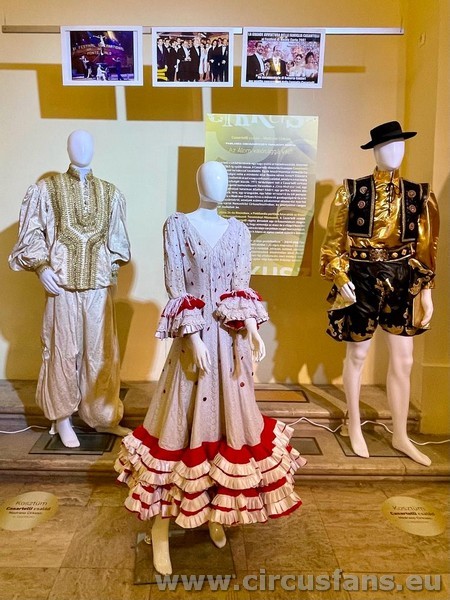

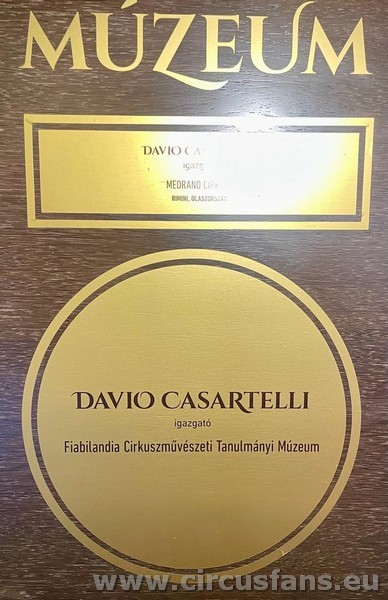

Aprendo la porta del museo del Circo del Medrano un grande schermo proietta immagini del Museo del Circo di Fiabilandia e dell'avventura al Festival di Monte Carlo realizzare da Roberto Guideri; poi i costumi storici e testali oltre a foto dal Festival International du Cirque de Monte-Carlo.

Il costume di Aladino e il testale degli elefanti dello stesso quadro

Costumi della famiglia Casartelli del Circo Medrano
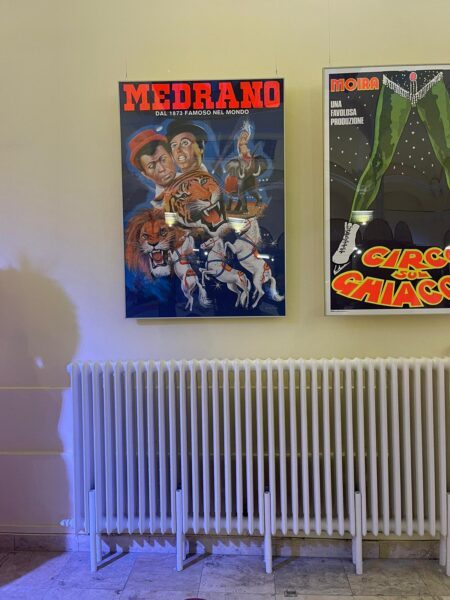
Fra i diversi costumi esposti nella sala è ben riconoscibile quello di Jozsef Richter utilizzato appunto anche a Monte-Carlo.
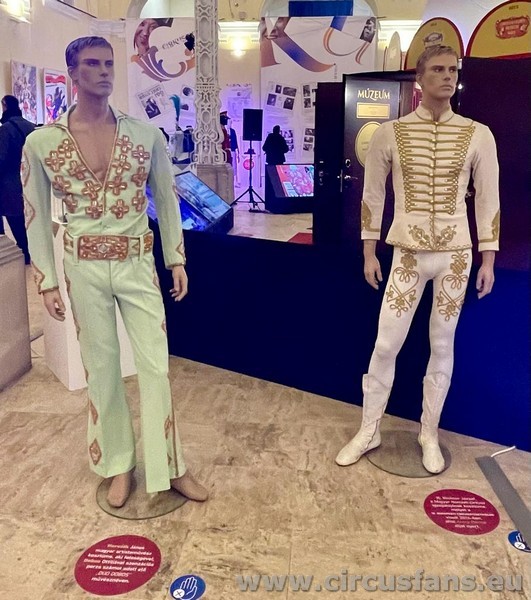
È quello inconfondibile dei Clown Rastelli.
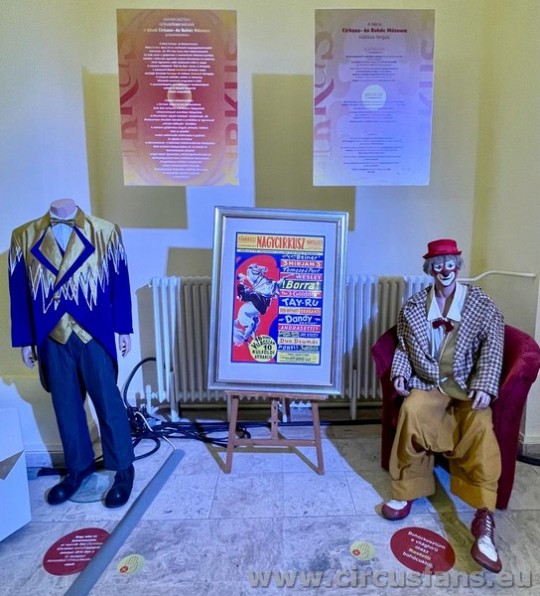
E grande spazio dato anche al connubio circo e cinema grazie alle fotobuste del Cedac di Verona.

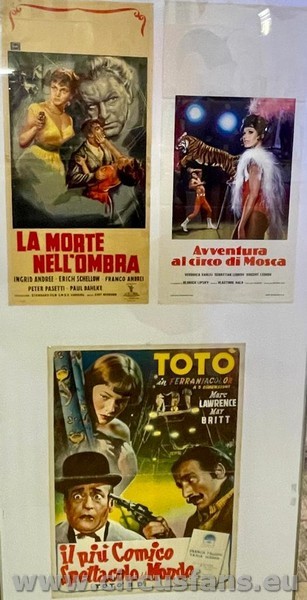


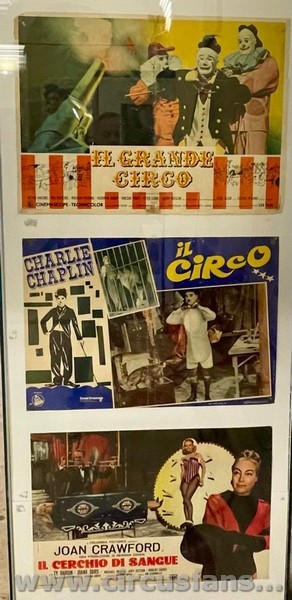
Affascinante anche una piccola sala dove è rappresentato il numero di bascule e su di un grande televisore sono proiettati alcuni spettacoli del circo stabile di Budapest.
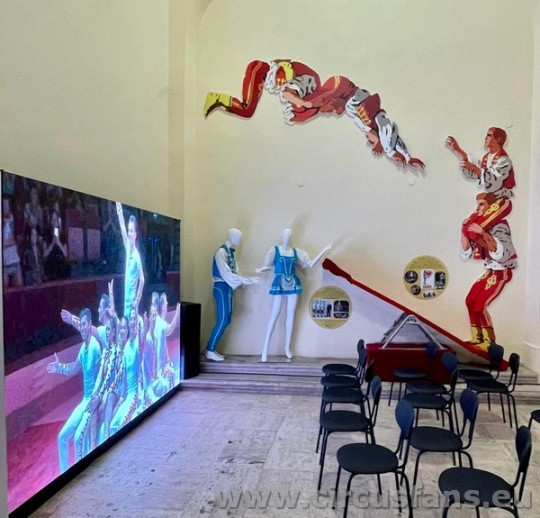
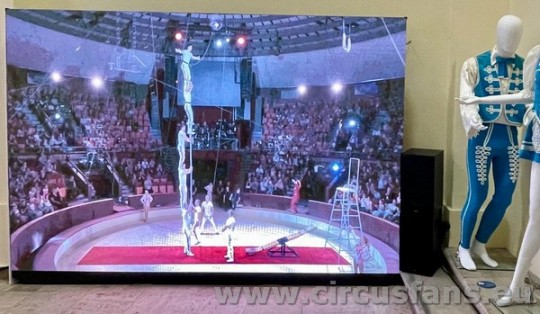
Una nicchia è riservata al Cirque du Soleil con i costumi dello spettacolo Corteo e un video con i momenti salienti dello show oltre che del back stage
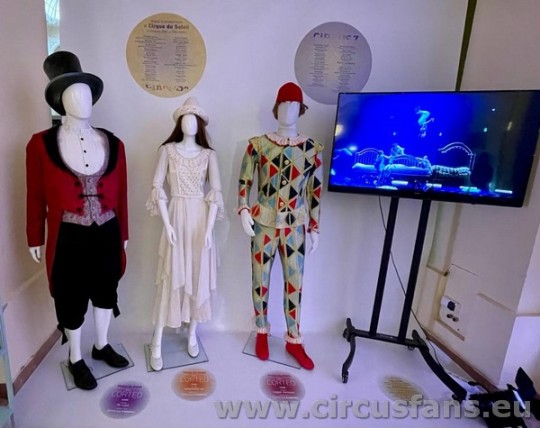

Una mostra veramente bella che da lustro al mondo del circo.
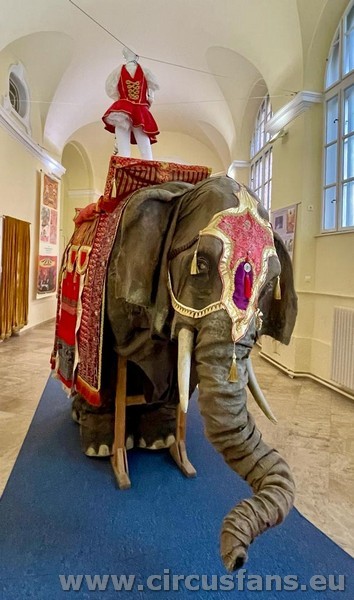

La mostra Wonderful Circus World rimarrà aperta dall'11/01/24 al 29/02/2024 presso il castello Vajdahunyad, sede del Museum of Hungarian Agriculture.
Guarda tutte le fotografie della mostra Wonderful Circus World
Scarica il biglietto sconto speciale amici di Circusfans Italia: ritaglia l’immagine qui sotto e consegnala alle casse del circo prescelto

Iscriviti ai nostri canali social: Facebook, Instagram, Twitter, Pinterest, Tumblr, Flickr e Tik Tok
E ..... per non perderti neanche una news iscriviti al canale Telegram di Circusfans Italia. Per raggiungerlo inquadra il QR Code con il tuo cellulare oppure clicca direttamente sull’immagine qui sotto.

Visita le nostre sezioni
ARCHIVIO STORICO
TOURNEE'
Per rimanere sempre aggiornati sulle tappe dei circhi italiani
WONDERFUL CIRCUS WORLD LA MOSTRA A BUDAPEST
Se questo articolo ti è piaciuto condividilo sui tuoi social utilizzando i bottoni che trovi qui sotto
Read the full article
1 note
·
View note
Photo
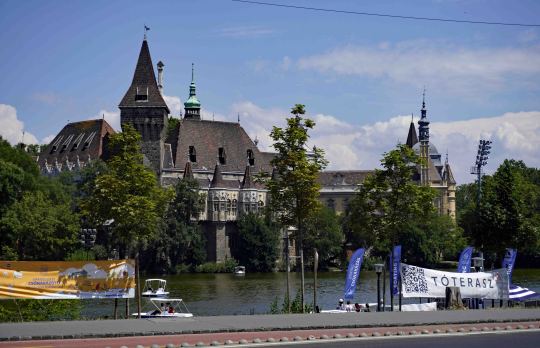
The guide was very proud that this Museum of Hungarian Agriculture building has eight different architectural styles
0 notes
Photo

Budapest. M. kir. Mezőgazdasági Múzeum
Budapest. K. ungarisches landwirtschaftliches Museum
2 notes
·
View notes
Photo

vajdahunyad vara
- originally a cardboard mockup, the castle’s popularity won it permanence in stone.
source: flaneurissimo
#vajdahunyad castle#budapest#1896#millennial exhibition#museum of hungarian agriculture#hungary#architecture#replicant#romanesque#gothic#renaissance#baroque#phone photography#photographers on tumblr
54 notes
·
View notes
Text
Notes for Life Unfolds in Chapters, Part IV
The political system Aleksander outlines for West and East Ravka is greatly influenced by the Austro-Hungarian Dual Monarchy. Hungary had been under absolutist Habsburg rule as a part of the Austrian Empire since the Turkish times, under which it bristled. In 1848-9, there was an attempt to gain independence by revolution, but it was crushed. However, in 1867 a compromise was reached, the Austrian Emperor, Franz Joseph, was crowned King of Hungary, and thus the Dual Monarchy was established. Franz Joseph’s wife, Elizabeth (Sisi), is often credited as being a champion of this compromise. She was rather fond of Hungary and Hungarians, and we still somewhat claim her as ours.
Alina’s dress from the chapter: Fawn colored day dress, 1882-3

I think I mentioned this during the last chapter, but: the park they first go to is based on the Budapest City Park (Városliget), and the castle on Vajdahunyad Castle, which currently houses the Museum of Agriculture (the exhibits they see there are completely works of my imagination.
They get on the underground at Heroes’ Square, and get off at what is called Deák Square today--both stations existed in the 1890s. Currently, there are four metro lines in Budapest, and three of the four intersect at Deák Square.
Their meal at the restaurant:
Fruit soup: one of my absolute favorite foods ever. It’s a sweet soup, served cold, sometimes with whipped cream, or even oat biscuits. The most common variant is made from sour cherries, but you can make it with basically any kind of fruit. It’s the perfect summer treat, and so common that sometimes places with daily menus will have two kinds of soup each day: something warm, different day after day, and fruit soup.

Chicken paprikash: I don’t have much to add here, I’m not a big fan, but it’s a very iconic Hungarian dish, so I had them have it.
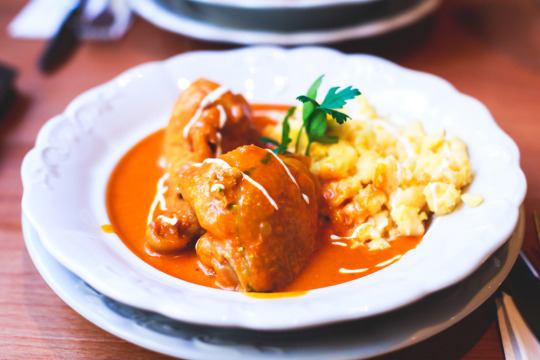
Dobos torte: a layered sponge cake with cocoa buttercream filling, with a layer of hardened caramel on the top. Very iconic, very nice. My dad’s favorite.

The island park they go to is based on Margaret Island, which, too, functions as a public park in real life. Next to what’s described in the chapter, it has an open-air theater, a pool, a 5K running track, playgrounds, several restaurants and clubs, and even a petting zoo. The “Shu-style garden” is based on the Japanese garden also found there.
Margaret Island is named after a Hungarian saint from the 13th century. In 1241-2, Hungary was under Mongol invasion, which greatly devastated the country. The queen was pregnant during that time, and the king, Béla IV, made a promise that if the Mongols left, he would dedicate the child to God. Well, the Mongols left, so Margaret (Margit, in the Hungarian style--9th child, 8th and youngest daughter) was thus raised as a Dominican nun. She lived her whole life on that island, back then known as the Island of Rabbits. I remember we had to read some stories about her in school, and they were about stuff like how basically she was into suffering and how the lice in her hair turned into pearls, which is… gross.
Chimney cake is the best. Damn, guys, if you come to Hungary, or if you happen to be at a place where it is sold, Do Not miss out on it. It’s basically street food, and I can list like three or four carts in the city from the top of my head where they sell it, for like a buck a piece (although none of those are on Margaret Island. I’m not even sure if you can buy it on Margaret Island, but, hey, artistic licence). Thanks to the caramelized sugar on the crust, it has a very strong, very characteristic (very appetizing) smell, so you can basically find the carts selling it by following your nose :D
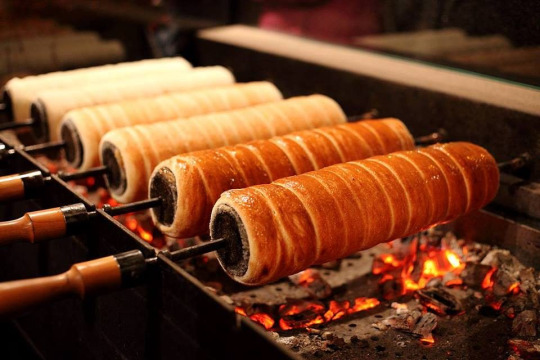
35 notes
·
View notes
Photo
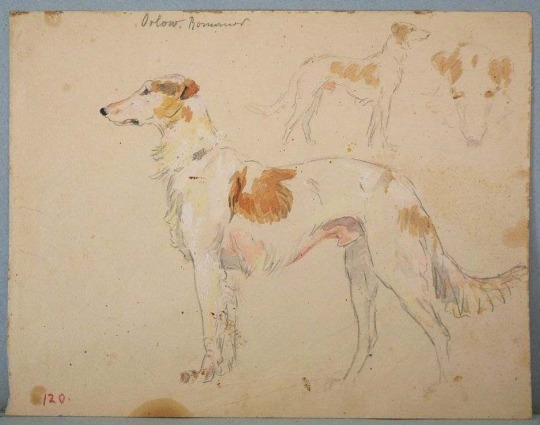
Hungarian Museum of Agriculture in Budapest
23 notes
·
View notes
Text

Personally, this is my all time favourite castle in Budapest. This is the monument I will never get tired of, it's so nice and the whole building with the garden and the inside is so so inspirational!! I can only recommend it!
"Vajdahunyad Castle is one of the romantic castles in Budapest, Hungary, located in the City Park by the boating lake / skating rink. The castle, despite all appearances, was built in 1896, and is in fact a fantasy pastiche showcasing the architectural evolution through centuries and styles in Hungary. The castle is the home of several festivals, concerts and the exhibitions of the Hungarian Agricultural Museum."
(picture and the edits are MINE!!)
#hungary#budapest#vajdahunyad castle#hungarian girl#capital city#photography#architecture#architecture photography#medieval#castle#huawei#snapseed
7 notes
·
View notes
Text
Festetics Palace




Festetics Palace is located in the town of Keszthely in Zala, Hungary. Kristof Festetics began construction on the Baroque castle in 1745. The Festetics family is one of the most significant ducal families in Hungary. In 1759, Kristof had a hospital established in the town. Kristof’s son Paul III became Court Chancellery, the Queen’s Confidential Advisor, and Vice-President to the Hungarian Chamber. He also founded the first primary and second schools of Keszthely. Paul’s son, George I, also made significant contributions to the area by establishing the first agricultural college in Europe, commissioning the vessel Phoenix Galley, and more. The U-shaped palace has 100 rooms, but it has been rebuilt, reconstructed, and enlarged throughout its history. George added an opulent library wing to the palace. The library consists of more than 86,000 items and is open to the public Monday-Friday, where books can be read onsite for a fee. George’s great-grandson, Tassilo II, was considered the “greatest Hungarian aristocrat.” He was Royal Court Chamberlain, Privy Councilor, and Lord Steward. He married English Princess Mary Hamilton and received the title of Prince by Emperor Franz Joseph. Between 1883-1887 Tassilo II had the northern wing of the castle demolished and a new one built with a turreted central section, almost doubling the size of the palace. He had the mansard roof added, along with central heating and plumbing. The Festetics family left the palace in 1944, likely due to Jewish deportations in their town. The Festetics were responsible for building the first synagogue in Keszthely in 1780. Although the history appears to be avoided, Jews with Hungarian surnames lived in Keszthely since 1735 under the local aristocrat protection like the Festetics family. In the summer of 1946, the palace served as a public agricultural school. The property belonged to the Festetics family until nationalized by the Communists in 1949. Festetics Palace is surrounded by a nature preserve that includes a pond, fountains, statues, and flowerbeds. The palace is Hungary’s third-largest in size and the most touristed. The property has the 1880 Palm House, which serves as a type of orangery, and many exhibitions, including the former coach house exhibition, a hunting exhibition, and the historical model railway exhibition near the back gate of the park. The palace houses the Helikon Palace Museum and serves as an events venue. #Castles #Palaces #FesteticsPalace #Hungary #Keszthely #Zala #HelikonPalaceMuseum #venue #Museum
#CASTLES#palaces#royal palaces#festetics palace#hungary#kesthely#zala#HelikonPalaceMuseum#venue#museum
8 notes
·
View notes
Photo

Róth Miksa: The Tree of Knowledge. Detail by Nori (Nóra Mészöly)
Art Nouveau glass mosaic, embossed parts coated with Zsolnay eosin glaze.www.youtube.com/watch?v=g0XotjqSAjA
Born in 1865, Miksa Róth was 19 years old when he took over his father Zsigmond’s workshop.The craft of glass painting was still in its infancy. In 1855 English glass workers succeeded in creating an "antique glass" effect.This coloured glass was suitable for the repair and restoration of the windows of medieval churches, as well as for decorating the new romantic, and the historically eclectic designs. By 1880, workshops were sprouting up in the capital, the most significant of which belonged to Miksa Róth, who at the turn of the century was providing work for 10 trainees, working on both public and private building commissions.Miksa Róth’s first significant work was in 1886 in Máriafalva (Mariasdorf, Austria) where Imre Steindl was leading the reconstruction of the Roman Catholic church.Earlier Róth had studied the stained glass windows of Gothic cathedrals on a tour of Europe.During the reconstruction of many other national monuments, Róth designed Gothic stained glass windows at Keszthely for the reconstruction of the Roman Catholic church led by Samu Pecz (architect of the main market hall in Budapest) in 1896.In Budapest, you can see examples of his beautiful work in the Gresham Palace (now the newly opened Four Seasons hotel), the Agricultural Museum, the Music Academy and the Andrássy Dining Room amongst many others. The plans for the stained glass windows of the Parliament building were prepared in 1890. Róth took into account both the staircase’s light source and the building’s interior decoration, and decided to use the Grotesque style originating from the Renaissance period.Reflecting the multi-coloured nature of Hungarian architecture at the turn of the century, Róth created windows in many styles: Historic, Hungarian Secession, Art Nouveau, Jugendstil and Viennese Secession.
11 notes
·
View notes
Photo

Vajdahunyad Castle is one of the romantic castles in Budapest, Hungary, located in the City Park by the boating lake / skating rink. The castle, despite all appearances, was built in 1896, and is in fact a fantasy pastiche showcasing the architectural evolution through centuries and styles in Hungary. The castle is the home of several festivals, concerts and the exhibitions of the Hungarian Agricultural Museum. Vajdahunyad Castle amalgamates some of the finest buildings in the historical Hungary into a single eclectic palace featuring styles from the Middle Ages to the 18th century: Romanesque, Gothic Renaissance, Baroque buildings, from the Romanesque church of the village Jak to the Baroque palace of Prince Paul Esterhazy I.
6 notes
·
View notes
Text
WONDERFUL CIRCUS WORLD LA MOSTRA A BUDAPEST

WONDERFUL CIRCUS WORLD LA MOSTRA A BUDAPEST
Nell’ambito delle manifestazioni collaterali al 15º Budapest Circus Festival, si sono tenute alcune conferenze dell' Eca (European Circus Association) ma soprattutto, nella giornata di venerdì, è stata inaugurata Wonderful Circus World, una grande mostra sulla storia del circo. La location della mostra è molto suggestiva essendo organizzata nel castello di Pest (non molto distante dal circo stabile) dove già attualmente risiede un museo dell’agricoltura. Ce la racconta Massimo Malagoli.

La mostra è organizzata in diverse sale dove è esposto molto molto materiale, come manifesti, costumi, sgabelli e testali di elefanti, finimenti per cavalli, scarpe e tantissimi altri oggetti.
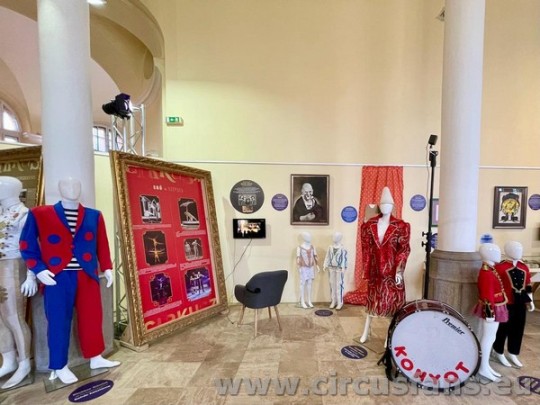



Una delle sale più grandi è dedicata al circo ungherese di un po' tutte le epoche, dal passato a quello più recente. In questa sala, si trovano costumi di famosi artisti che hanno fatto la storia del circo, sia ungherese sia internazionale. Viene proposto materiale che copre almeno gli ultimi 60 anni.
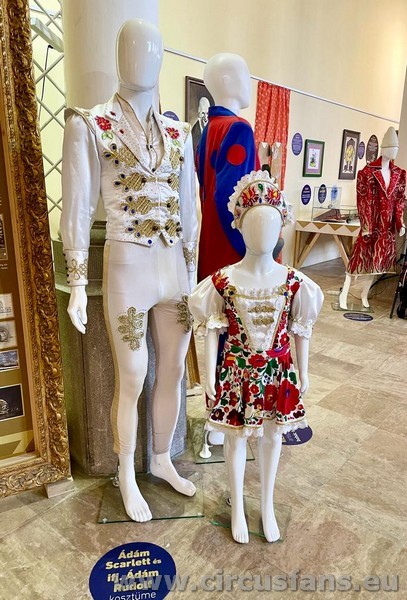


Fra i costumi più recenti, ve ne sono alcuni appartenenti alla famiglia Eotvos (ndr Susy Eotvos attualmente è responsabile delle relazioni internazionali del Festival, mentre al famiglia di Lorand Eotvos, con il suo numero di giocoleria, è attualmente nel programma del circo Busnelli) e alla famiglia Richter.

Un ponte tra passato e futuro sono poi i due plastici del circo stabile di Budapest, il plastico del circo attuale e di quello di prossima realizzazione.

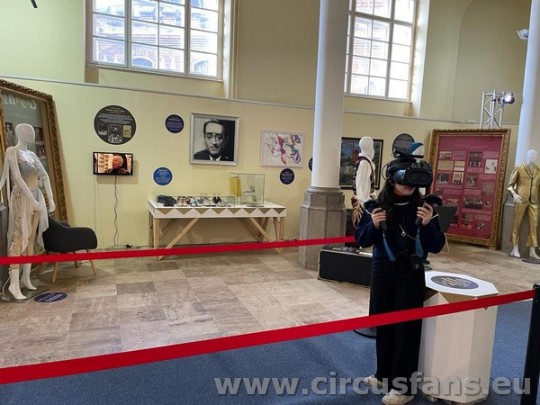
Ma c’è anche un grande schermo dove viene proiettata la celebre camminata sul Danubio di Lazlo Simet. Molto suggestiva è la possibilità, grazie alla realtà virtuale di provare a vivere un’esperienza analoga.
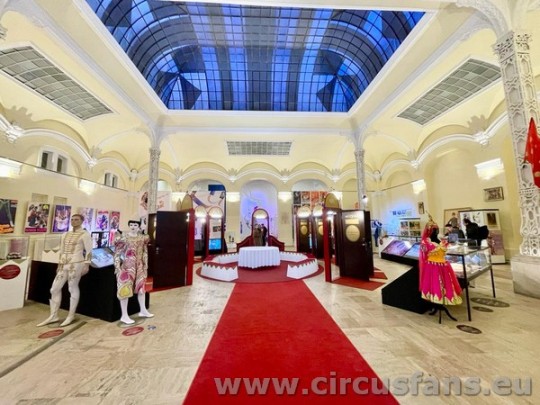

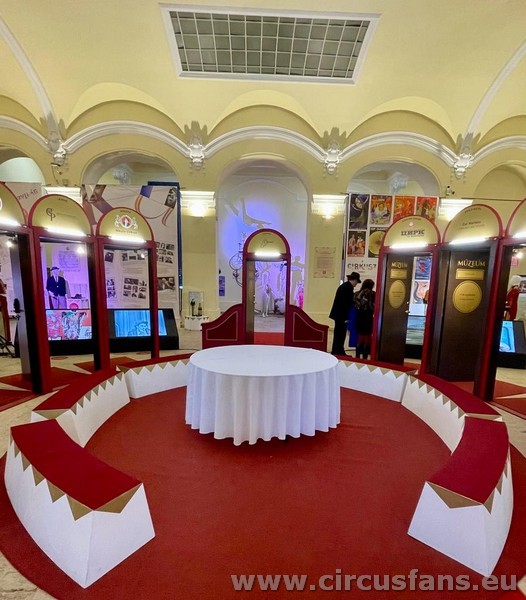



Un’altra grande sala è invece dedicata al circo europeo e alla sua storia, grazie anche al contributo di una dozzina di collezionisti molto rinomati che hanno prestato parte del proprio materiale. Fra questi il Cirque d’Hiver Bouglione, il circus Krone, il Circus & Clownmuseum di Vienna, il circus Roncalli ma una parte molto importante è rappresentata anche dal contributo italiano grazie al materiale del Cedac, del Circo Medrano e del Museo del Circo di Fiabilandia e alla collezione di Roberto Fazzini.

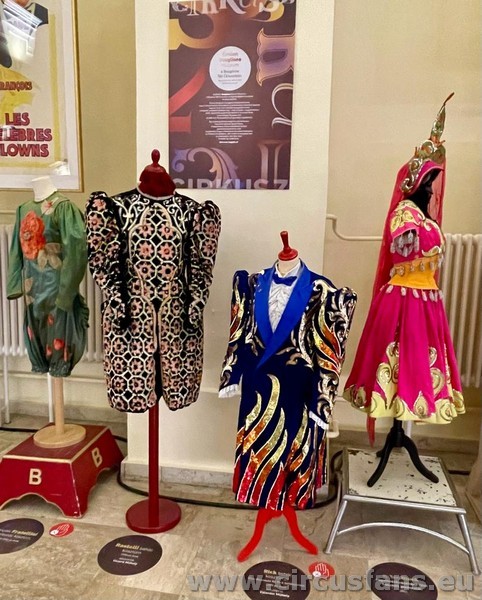
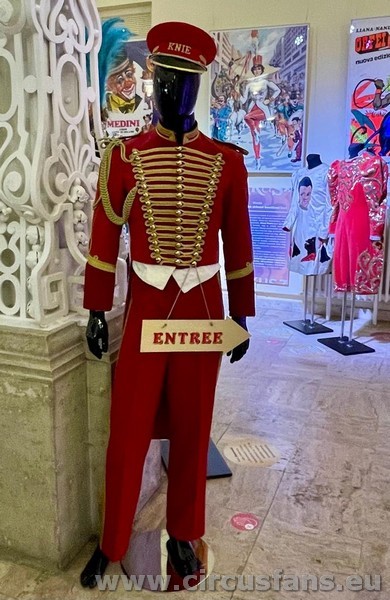
Alcuni degli oggetti esposti fra i quali si può ammirare il costume le scarpe di Nikulin, un costume di Martin Lacey jr e uno di Christel Sembach-Krone.


Dalla collezione di Roberto Fazzini alcuni manifesti italiani famosissimi così come alcuni costumi originali e storici.




L'accesso alle collezioni del circo europeo avviene aprendo delle porte poste a semicerchio.



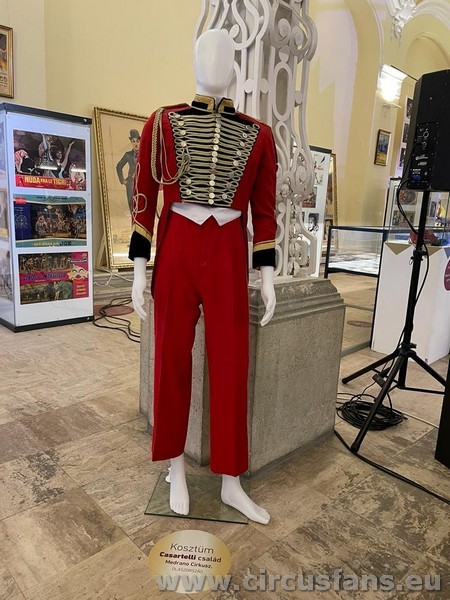
Aprendo la porta del museo del Circo del Medrano un grande schermo proietta immagini del Museo del Circo di Fiabilandia e poi di costumi storici oltre a foto dal Festival International du Cirque de Monte-Carlo.
Fra i diversi costumi esposti nella sala è ben riconoscibile quello di Jozsef Richter utilizzato appunto anche a Monte-Carlo.

È quello inconfondibile dei Clown Rastelli.

E grande spazio dato anche al connubio circo e cinema.





Affascinante anche una piccola sala dove è rappresentato il numero di bascule e su di un grande televisore sono proiettati alcuni spettacoli del circo stabile di Budapest.

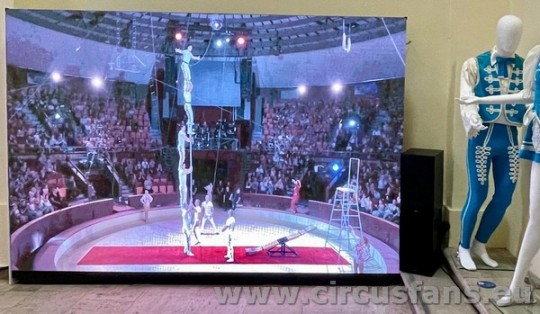
Una nicchia è riservata al Cirque du Soleil con i costumi dello spettacolo Corteo e un video con i momenti salienti dello show oltre che del back stage


Una mostra veramente bella che da lustro al mondo del circo.


La mostra Wonderful Circus World rimarrà aperta dall'11/01/24 al 29/02/2024 presso il castello Vajdahunyad, sede del Museum of Hungarian Agriculture.
Guarda tutte le fotografie della mostra Wonderful Circus World
Scarica il biglietto sconto speciale amici di Circusfans Italia: ritaglia l’immagine qui sotto e consegnala alle casse del circo prescelto

Iscriviti ai nostri canali social: Facebook, Instagram, Twitter, Pinterest, Tumblr, Flickr e Tik Tok
E ..... per non perderti neanche una news iscriviti al canale Telegram di Circusfans Italia. Per raggiungerlo inquadra il QR Code con il tuo cellulare oppure clicca direttamente sull’immagine qui sotto.

Visita le nostre sezioni
ARCHIVIO STORICO
TOURNEE'
Per rimanere sempre aggiornati sulle tappe dei circhi italiani
WONDERFUL CIRCUS WORLD LA MOSTRA A BUDAPEST
Se questo articolo ti è piaciuto condividilo sui tuoi social utilizzando i bottoni che trovi qui sotto
Read the full article
0 notes
